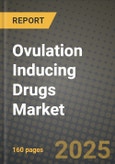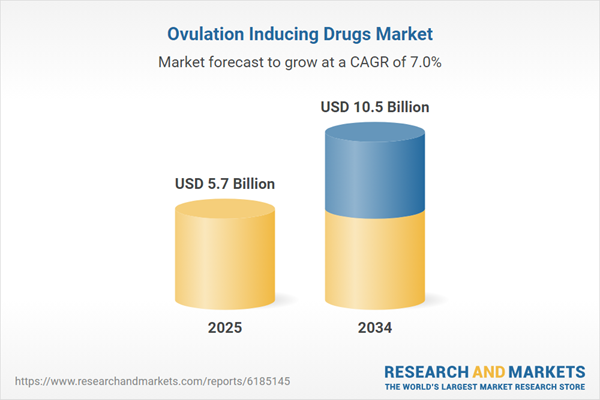The ovulation-inducing drugs market is experiencing steady growth, driven by rising infertility rates, increasing awareness of fertility treatments, and advancements in reproductive medicine. Ovulation-inducing drugs, such as clomiphene citrate, letrozole, and gonadotropins, are widely used to stimulate ovulation in women experiencing ovulatory disorders, polycystic ovary syndrome (PCOS), or unexplained infertility. The growing prevalence of lifestyle-related factors such as obesity, stress, and delayed pregnancies has led to an increased demand for fertility treatments. Additionally, improvements in assisted reproductive technologies (ART), including in-vitro fertilization (IVF) and intrauterine insemination (IUI), are further driving market expansion. Pharmaceutical companies are investing in research and development to introduce improved formulations with enhanced efficacy and fewer side effects. Moreover, government initiatives supporting fertility treatments and the expansion of insurance coverage for infertility drugs are expected to fuel market growth.
The ovulation-inducing drugs market saw notable advancements in drug development, personalized fertility treatment approaches, and regulatory approvals. The year witnessed an increasing preference for letrozole over traditional clomiphene citrate due to its higher success rates and lower risk of multiple pregnancies. Biosimilars of gonadotropins gained traction, offering more cost-effective treatment options for patients undergoing ART. AI-driven fertility tracking apps and wearable devices became integral to ovulation monitoring, improving the effectiveness of fertility treatments by enabling precise cycle predictions. Pharmaceutical companies launched innovative drug delivery mechanisms, such as pre-filled self-injection pens for gonadotropins, enhancing patient convenience. Additionally, regulatory agencies fast-tracked approvals for novel ovulation-inducing therapies, allowing more treatment options to reach the market. Expanding fertility clinic networks, particularly in emerging economies, contributed to wider accessibility and affordability of ovulation-inducing drugs, further strengthening market growth.
The ovulation-inducing drugs market is expected to evolve with further advancements in AI-powered fertility solutions, precision medicine, and expanded insurance coverage for infertility treatments. The integration of AI with reproductive health will enhance the personalization of ovulation induction protocols, optimizing drug dosages and treatment timelines based on individual patient profiles. Innovations in hormone therapy, including long-acting gonadotropins and oral alternatives to injectable treatments, will improve patient compliance and treatment outcomes. The increasing role of telemedicine in fertility care will enhance accessibility, particularly in rural and underserved regions. Additionally, pharmaceutical companies will focus on developing eco-friendly and bioidentical hormone-based ovulation-inducing drugs to reduce the risk of side effects. With rising demand for fertility preservation and delayed childbearing trends, the market for ovulation-inducing drugs will continue to expand, supported by technological advancements and evolving reproductive healthcare policies.
Key Insights: Ovulation Inducing Drugs Market
- Rising Preference for Letrozole Over Clomiphene Citrate: Letrozole is increasingly used due to its higher efficacy in ovulation induction and reduced risk of multiple pregnancies.
- Growth of AI-Powered Fertility Tracking and Monitoring: Digital health tools and wearable devices are improving ovulation prediction, enhancing the success rates of fertility treatments.
- Expansion of Biosimilars for Cost-Effective Treatment: The introduction of biosimilar gonadotropins is making fertility treatments more affordable and accessible for a larger patient base.
- Development of Patient-Friendly Drug Delivery Systems: Pre-filled pens and auto-injectors for gonadotropins are improving convenience and reducing the burden of self-administration.
- Increased Role of Telemedicine in Fertility Care: Remote consultations and digital fertility treatment platforms are expanding access to ovulation-inducing medications.
- Rising Prevalence of Infertility and Delayed Pregnancies: Lifestyle factors, hormonal disorders, and increasing maternal age are driving demand for ovulation-inducing treatments.
- Advancements in Assisted Reproductive Technologies (ART): The integration of ovulation-inducing drugs with IVF and IUI procedures is improving success rates and expanding market demand.
- Government and Insurance Support for Fertility Treatments: Policies promoting fertility care and expanded insurance coverage for infertility medications are fueling market growth.
- Ongoing Research and Development in Fertility Drugs: Pharmaceutical companies are investing in new formulations with improved efficacy, reduced side effects, and better patient compliance.
- High Treatment Costs and Limited Access in Low-Income Regions: The affordability of fertility drugs and treatments remains a barrier, restricting access to advanced reproductive care in developing economies.
Ovulation Inducing Drugs Market Segmentation
By Drug Class
- Hormones
- Therapeutics Drugs
By Route Of Administration
- Oral
- Parenteral
- Other Routes Of Administration
By End-User
- Hospital
- Homecare
- Specialty Clinics
- Other End-Users
Key Companies Analysed
- Pfizer Inc.
- Johnson and Johnson Pvt Ltd.
- Merck and Co. Inc.
- Abbvie Inc.
- Novartis AG
- Bayer AG
- Sanofi SA
- Abbott Laboratories
- Gilead Sciences Inc.
- Amgen Inc.
- Teva Pharmaceutical Industries Ltd.
- Janssen Pharmaceutical Inc.
- Mylan N.V
- Astellas Pharma Inc.
- Sun Pharmaceuticals Industries Ltd.
- Aurobindo Pharma Limited
- Dr Reddy's Laboratories Ltd.
- Intas Pharmaceuticals Limited
- Endo International Inc.
- Ferring Pharmaceuticals Inc.
- Lupin Limited
- LIVZON Pharmaceutical Group Inc.
- Torrent Pharmaceuticals Ltd.
- Gedeon Richter plc
- Glenmark Pharmaceuticals Ltd.
- Fresenius Kabi AG
- Zydus Pharmaceuticals (USA) Inc.
- Serum Institute of India Ltd.
- EMD Serono Inc.
- Cipla Inc.
Ovulation Inducing Drugs Market Analytics
The report employs rigorous tools, including Porter’s Five Forces, value chain mapping, and scenario-based modeling, to assess supply-demand dynamics. Cross-sector influences from parent, derived, and substitute markets are evaluated to identify risks and opportunities. Trade and pricing analytics provide an up-to-date view of international flows, including leading exporters, importers, and regional price trends.Macroeconomic indicators, policy frameworks such as carbon pricing and energy security strategies, and evolving consumer behavior are considered in forecasting scenarios. Recent deal flows, partnerships, and technology innovations are incorporated to assess their impact on future market performance.
Ovulation Inducing Drugs Market Competitive Intelligence
The competitive landscape is mapped through proprietary frameworks, profiling leading companies with details on business models, product portfolios, financial performance, and strategic initiatives. Key developments such as mergers & acquisitions, technology collaborations, investment inflows, and regional expansions are analyzed for their competitive impact. The report also identifies emerging players and innovative startups contributing to market disruption.Regional insights highlight the most promising investment destinations, regulatory landscapes, and evolving partnerships across energy and industrial corridors.
Countries Covered
- North America - Ovulation Inducing Drugs market data and outlook to 2034
- United States
- Canada
- Mexico
- Europe - Ovulation Inducing Drugs market data and outlook to 2034
- Germany
- United Kingdom
- France
- Italy
- Spain
- BeNeLux
- Russia
- Sweden
- Asia-Pacific - Ovulation Inducing Drugs market data and outlook to 2034
- China
- Japan
- India
- South Korea
- Australia
- Indonesia
- Malaysia
- Vietnam
- Middle East and Africa - Ovulation Inducing Drugs market data and outlook to 2034
- Saudi Arabia
- South Africa
- Iran
- UAE
- Egypt
- South and Central America - Ovulation Inducing Drugs market data and outlook to 2034
- Brazil
- Argentina
- Chile
- Peru
Research Methodology
This study combines primary inputs from industry experts across the Ovulation Inducing Drugs value chain with secondary data from associations, government publications, trade databases, and company disclosures. Proprietary modeling techniques, including data triangulation, statistical correlation, and scenario planning, are applied to deliver reliable market sizing and forecasting.Key Questions Addressed
- What is the current and forecast market size of the Ovulation Inducing Drugs industry at global, regional, and country levels?
- Which types, applications, and technologies present the highest growth potential?
- How are supply chains adapting to geopolitical and economic shocks?
- What role do policy frameworks, trade flows, and sustainability targets play in shaping demand?
- Who are the leading players, and how are their strategies evolving in the face of global uncertainty?
- Which regional “hotspots” and customer segments will outpace the market, and what go-to-market and partnership models best support entry and expansion?
- Where are the most investable opportunities - across technology roadmaps, sustainability-linked innovation, and M&A - and what is the best segment to invest over the next 3-5 years?
Your Key Takeaways from the Ovulation Inducing Drugs Market Report
- Global Ovulation Inducing Drugs market size and growth projections (CAGR), 2024-2034
- Impact of Russia-Ukraine, Israel-Palestine, and Hamas conflicts on Ovulation Inducing Drugs trade, costs, and supply chains
- Ovulation Inducing Drugs market size, share, and outlook across 5 regions and 27 countries, 2023-2034
- Ovulation Inducing Drugs market size, CAGR, and market share of key products, applications, and end-user verticals, 2023-2034
- Short- and long-term Ovulation Inducing Drugs market trends, drivers, restraints, and opportunities
- Porter’s Five Forces analysis, technological developments, and Ovulation Inducing Drugs supply chain analysis
- Ovulation Inducing Drugs trade analysis, Ovulation Inducing Drugs market price analysis, and Ovulation Inducing Drugs supply/demand dynamics
- Profiles of 5 leading companies - overview, key strategies, financials, and products
- Latest Ovulation Inducing Drugs market news and developments
Additional Support
With the purchase of this report, you will receive:- An updated PDF report and an MS Excel data workbook containing all market tables and figures for easy analysis.
- 7-day post-sale analyst support for clarifications and in-scope supplementary data, ensuring the deliverable aligns precisely with your requirements.
- Complimentary report update to incorporate the latest available data and the impact of recent market developments.
This product will be delivered within 1-3 business days.
Table of Contents
Companies Mentioned
- Pfizer Inc.
- Johnson And Johnson Pvt Ltd.
- Merck And Co. Inc.
- Abbvie Inc.
- Novartis AG
- Bayer AG
- Sanofi SA
- Abbott Laboratories
- Gilead Sciences Inc.
- Amgen Inc.
- Teva Pharmaceutical Industries Ltd.
- Janssen Pharmaceutical Inc.
- Mylan N.V
- Astellas Pharma Inc.
- Sun Pharmaceuticals Industries Ltd.
- Aurobindo Pharma Limited
- Dr Reddy's Laboratories Ltd.
- Intas Pharmaceuticals Limited
- Endo International Inc.
- Ferring Pharmaceuticals Inc.
- Lupin Limited
- LIVZON Pharmaceutical Group Inc.
- Torrent Pharmaceuticals Ltd.
- Gedeon Richter PLC
- Glenmark Pharmaceuticals Ltd.
- Fresenius Kabi AG
- Zydus Pharmaceuticals (USA) Inc.
- Serum Institute of India Ltd.
- EMD Serono Inc.
- Cipla Inc.
Table Information
| Report Attribute | Details |
|---|---|
| No. of Pages | 160 |
| Published | October 2025 |
| Forecast Period | 2025 - 2034 |
| Estimated Market Value ( USD | $ 5.7 Billion |
| Forecasted Market Value ( USD | $ 10.5 Billion |
| Compound Annual Growth Rate | 6.9% |
| Regions Covered | Global |
| No. of Companies Mentioned | 30 |









